This chickweed salve made with infused oil is an easy recipe using the common chickweed plant. Chickweed is a skin-beneficial and healing weed that can be found growing wildly in most regions. Learn how to make infused chickweed oil, and use it to make a healing and soothing salve!
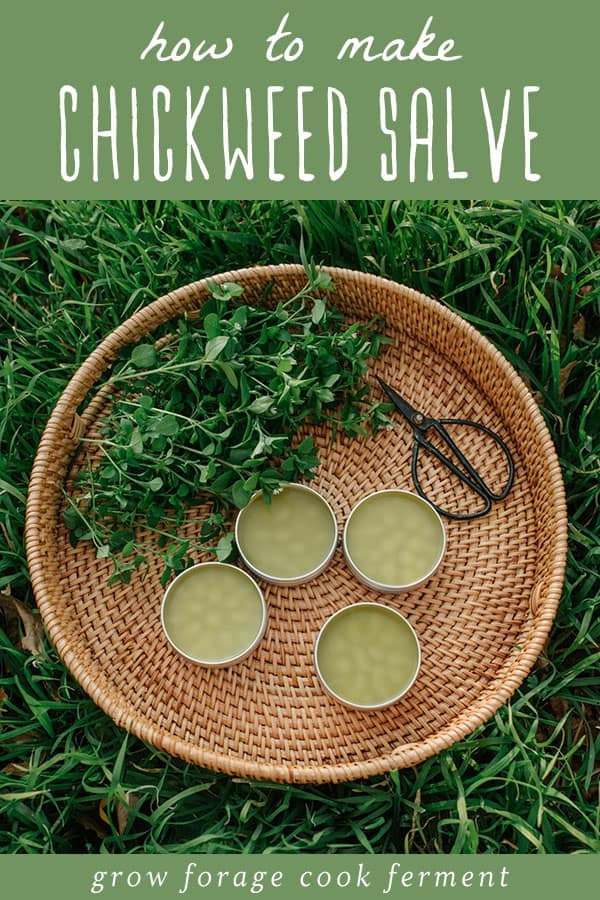
Want to save this post for later?
Wildcrafting Weeds
If you want to learn more about the edible and medicinal weeds that surround us and how to use them, check out my eBook: Wildcrafting Weeds: 20 Easy to Forage Edible and Medicinal Plants (that might be growing in your backyard)!
Chickweed Benefits
The chickweed plant is an unassuming, low-growing, common weed that grows wildly in large patches almost everywhere. It is easy to find, and you likely won’t have to venture much beyond your backyard when looking for it!
Chickweed is edible and delicious. Try it in my chickweed pesto recipe!
Chickweed is also highly medicinal, with wonderful benefits to the skin. It contains saponins, which makes it cooling and soothing on the skin.
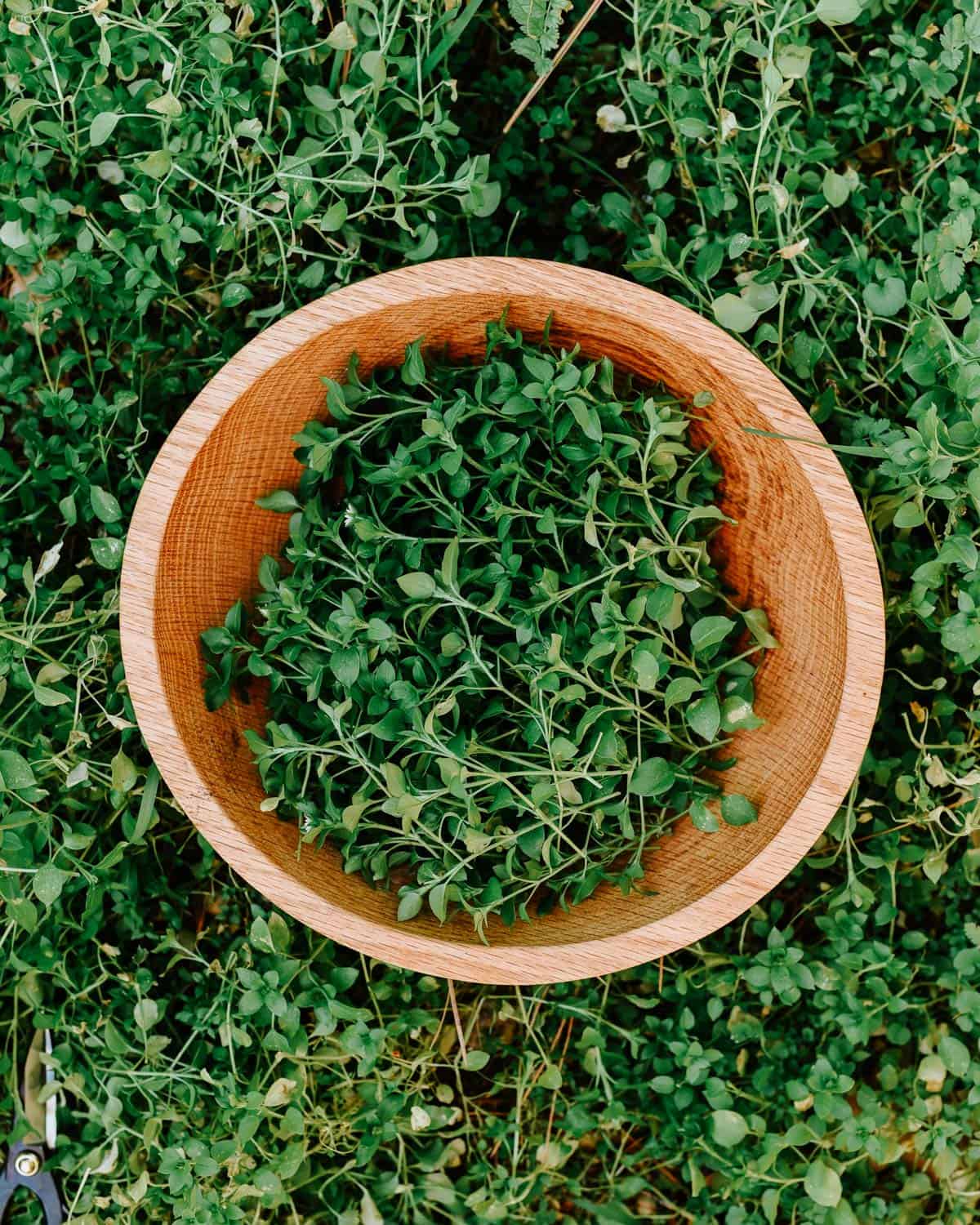
Making a salve with chickweed is an easy way to access its topical benefits! This salve can be used for healing and soothing skin ailments like eczema, rashes, bug bites, or otherwise dry and itchy skin.
Common chickweed will reduce inflammation, and it has also been said that chickweed salve can be used to help treat lipomas.
Chickweed salve is safe to use on the whole family, including children. In fact, you can find the chickweed plant as an ingredient in my herbal diaper rash salve!
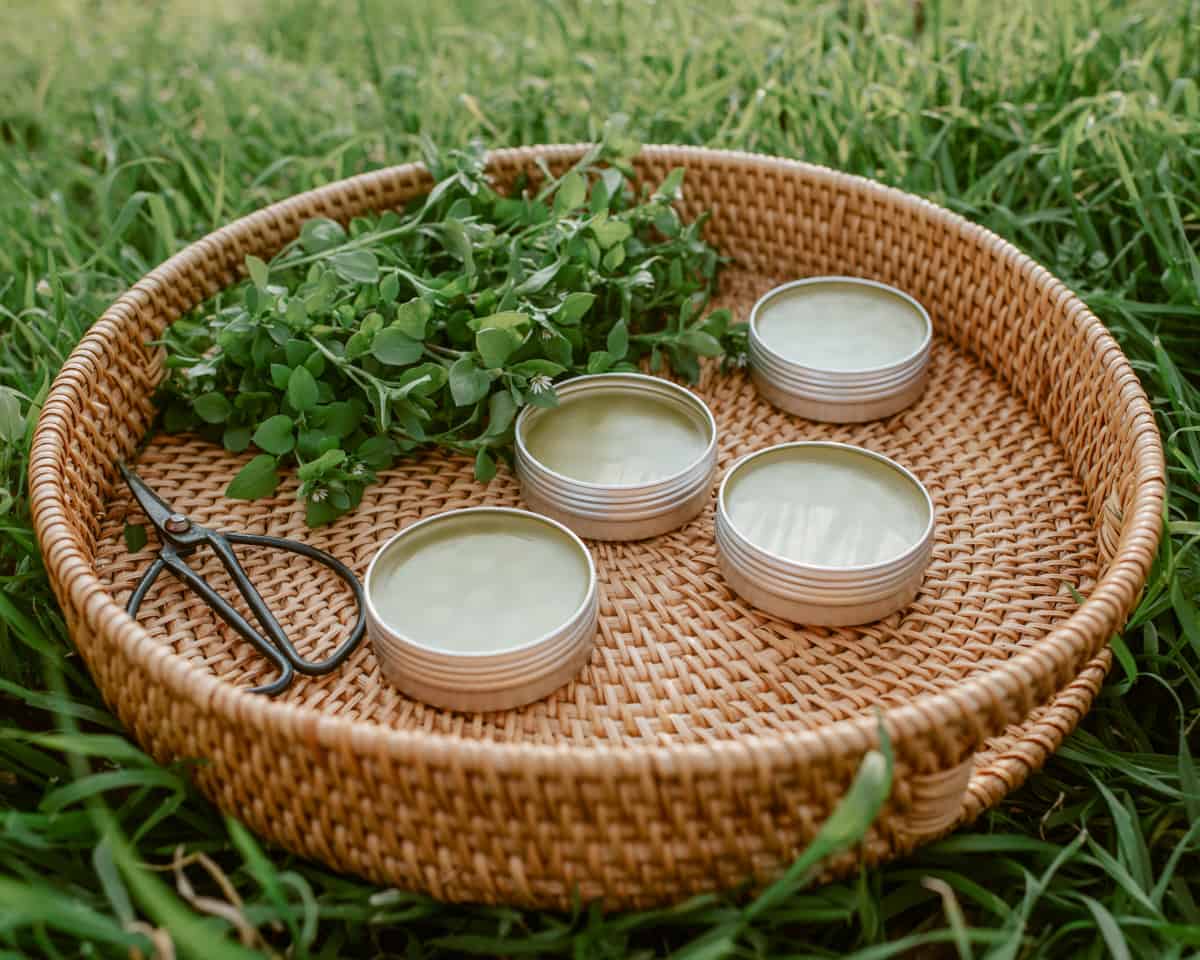
How to Make Infused Chickweed Oil
The first step before making this salve is to make an infused chickweed oil.
This is an easy process that begins with going outside to forage and ends by letting the oil rest and infuse at a low temperature for a long period of time.
Both of those steps speak to me as natural and easy to fit into any day!
Forage for Fresh Chickweed
The very first step in making this healing chickweed salve is to forage for chickweed, it takes about 2 large handfuls for this recipe.
Make sure to find a patch that is away from roads and pesticide spray, a great place to begin looking is in your own yard!
Chickweed often grows alongside other plants, like cleavers, grass, and miner’s lettuce, so be sure to remove any other plant parts from the forage. If necessary, rinse off the chickweed and gently pat it dry.
Harvesting tip: Chickweed has delicate roots that get uprooted easily, so the best way to harvest it is with a pair of sharp scissors. Gently take a handful of chickweed, and carefully cut it with the scissors, leaving the roots intact.
Related: What to Forage in Spring: 20 Edible and Medicinal Plants and Fungi
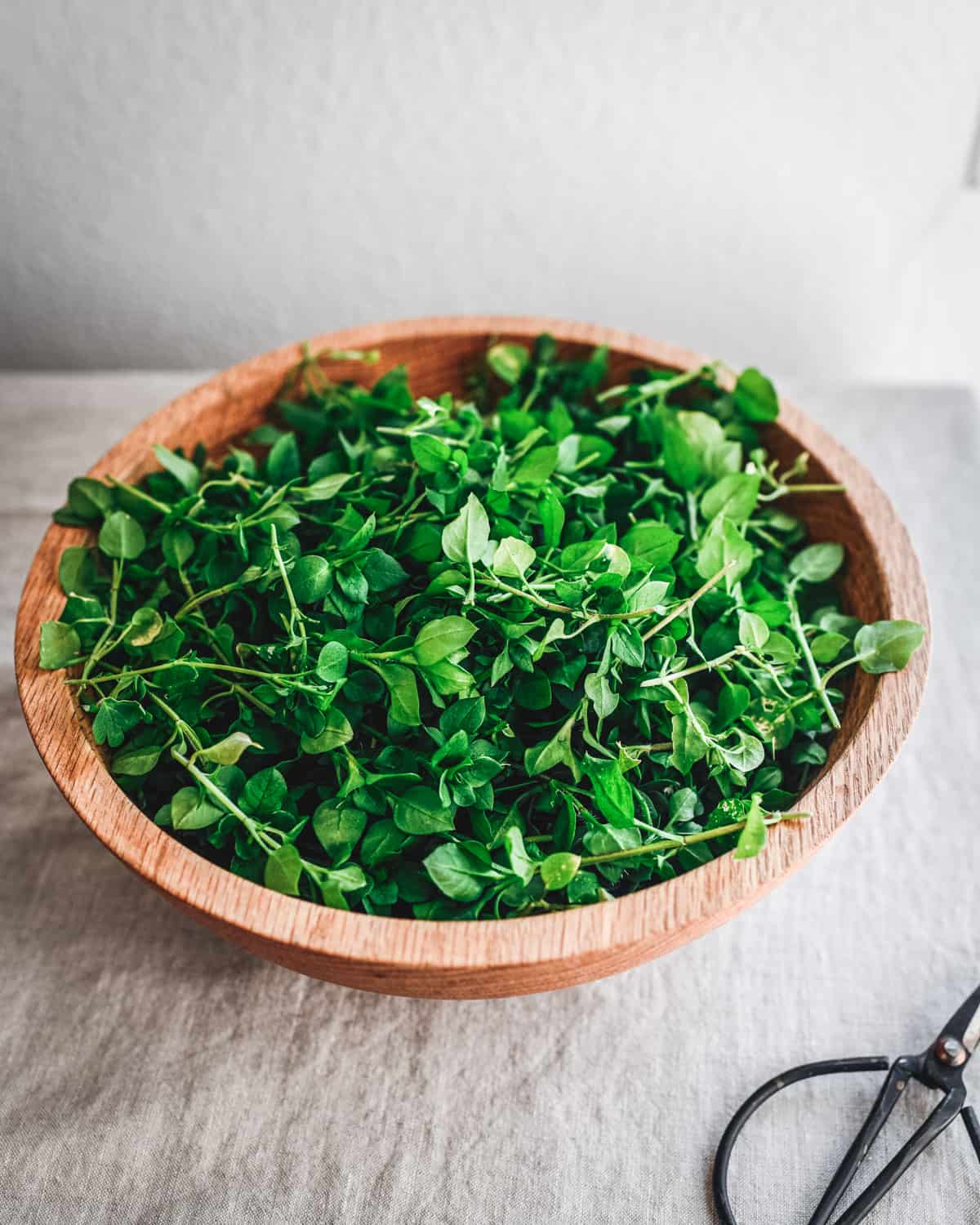
Wilt the Chickweed Overnight
Place the chickweed spread out on a flat surface, like a large cutting board. Let it sit out of direct sunlight for 12 hours, or overnight, to wilt.
Chickweed has high water content when fresh, so if it is placed in oil too soon after harvesting, the water will end up in the oil which could cause the chickweed oil and chickweed salve to grow mold.
It’s best not to let the chickweed completely dry out since it is a delicate plant that is most potent when fresh.
The wilting process allows some of the moisture to evaporate out of the plant, so water won’t get in the oil infusion. Partially drying the chickweed is a good balance to keep the oil and salve fresh while still being able to use this healing weed’s potency!
This is a similar to the method I use when making dandelion salve.
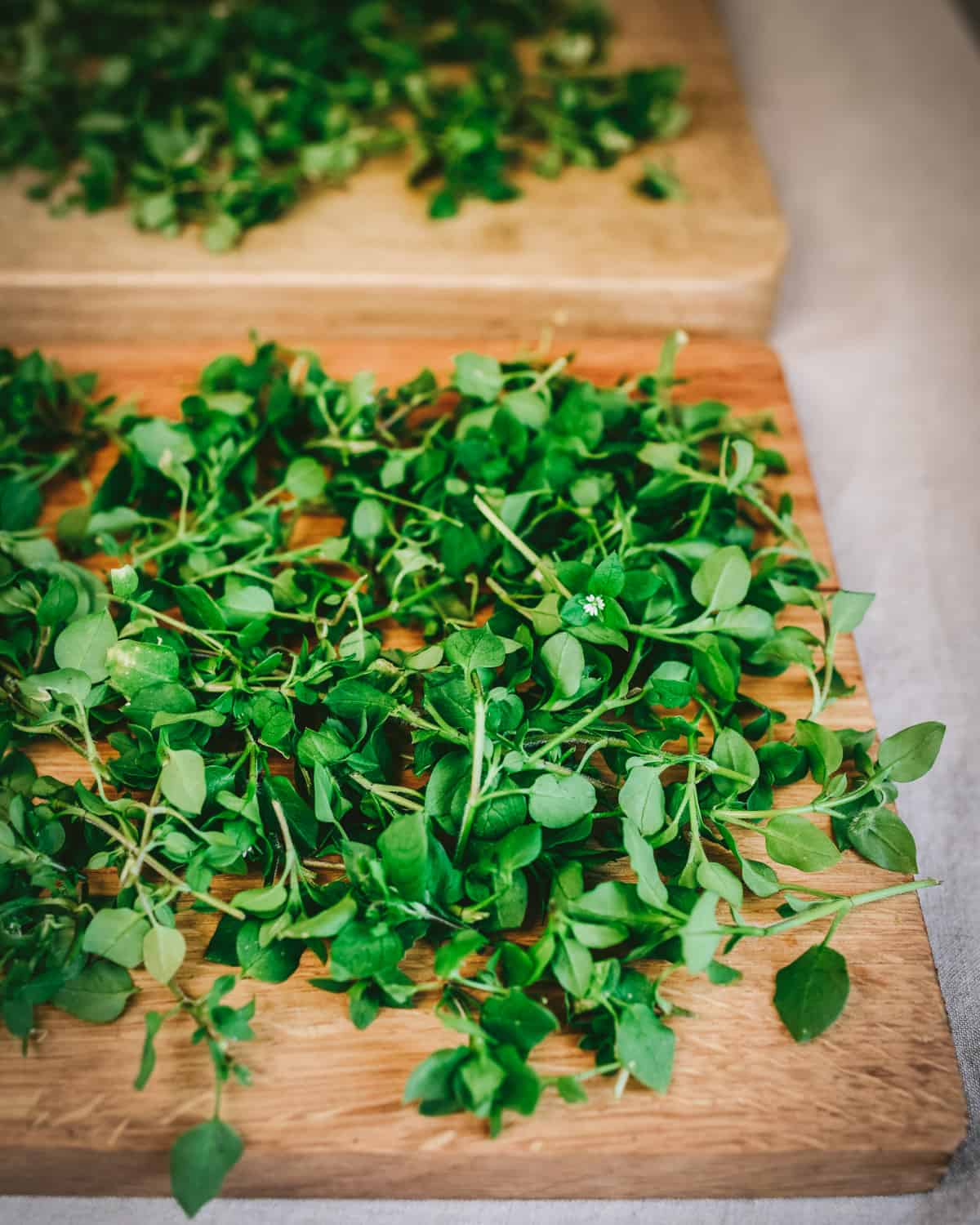
Infuse the Chickweed in Oil
Once the chickweed is partially dry, finely chop it with a sharp knife and place it in a pint jar.
Pour extra virgin olive oil into the jar to cover the chickweed.
Then, gently heat the oil at a very low temperature for 24-48 hours to infuse the plant into the oil, and to allow any water to evaporate off.
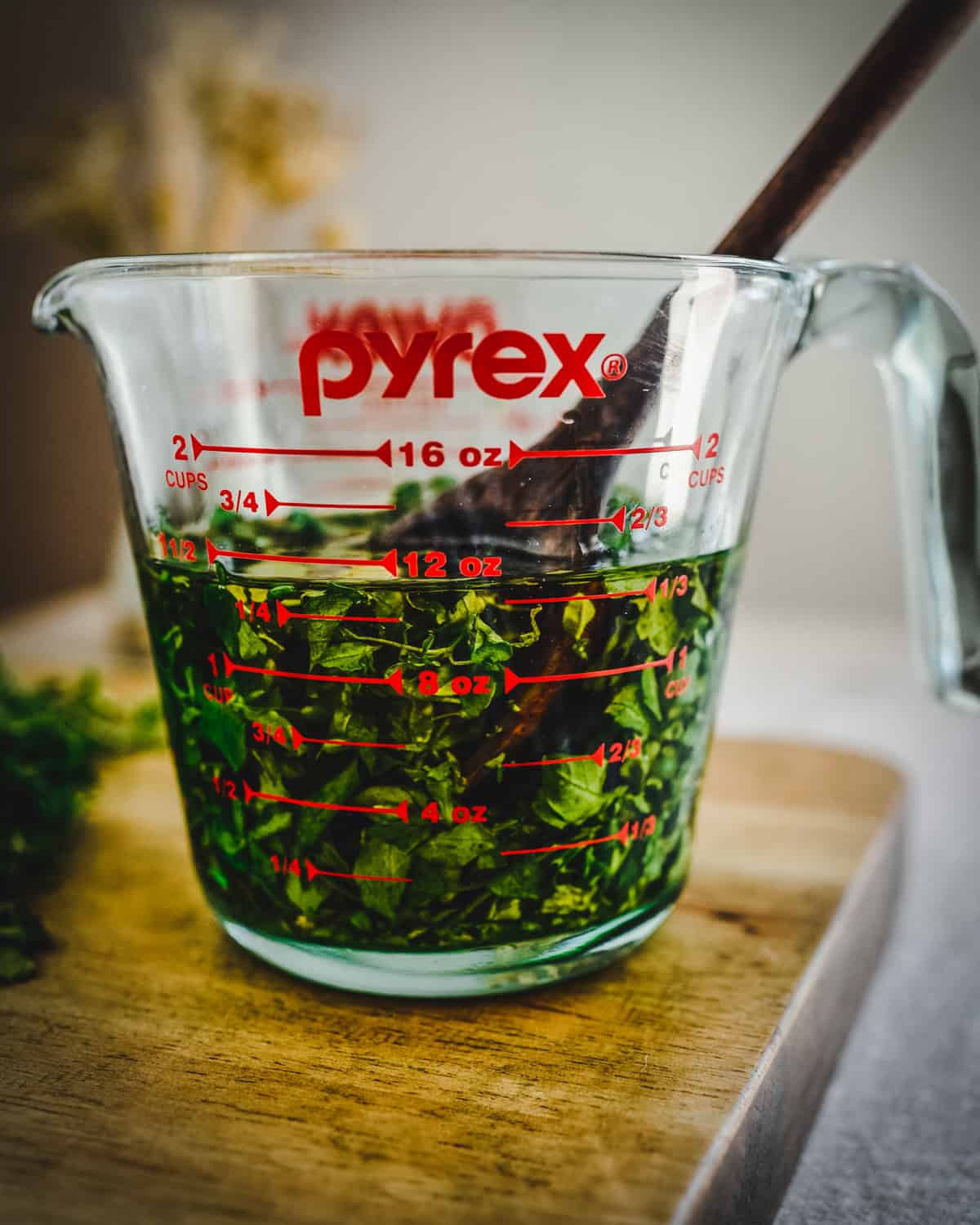
Methods to Heat the Oil Infusion
There are several methods that can be used when infusing oil with heat. The key is to use a very low temperature, ideally no higher than 100 degrees Fahrenheit.
Choose which method works the best for you using what you have!
Stove Top Method: Place the oil and herb mixture in a double boiler and heat on very low, using a thermometer to make sure it doesn’t rise above 100 degrees Fahrenheit.
Turn on and off for the next 24 to 48 hours, allowing any water to evaporate off and the medicine to infuse into the oil. Make sure the oil doesn’t reach boiling.
Yogurt Maker: Place the oil and chickweed in a pint jar, close the lid, and place inside the glass canister of the yogurt maker. Place the cover on the yogurt maker and fill the reservoir with water.
Set the temperature to 100 degrees Fahrenheit and the time for 24 hours. Check the oil after 24 hours and infuse longer if needed.
I let mine infuse for about 36 hours in my yogurt maker and it turned out wonderfully.
Dehydrator: If you have an Excalibur dehydrator (or a similar box style dehydrator with temperature control), it can also be used to heat infuse the oil. Set the temperature to 100 degrees and place the jar with the chickweed and oil in the dehydrator for 24-48 hours
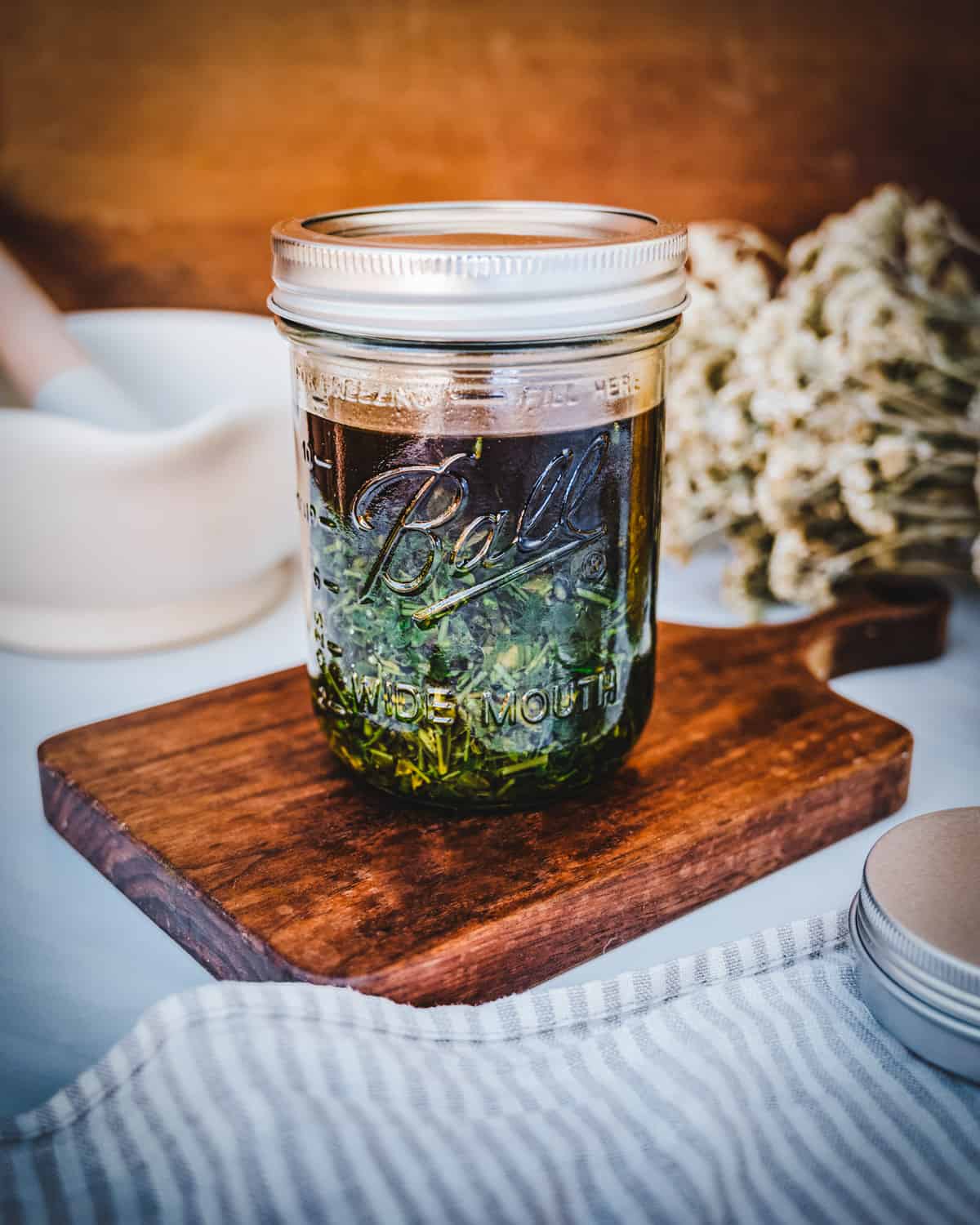
Strain the Oil
Using a fine-mesh strainer lined with a muslin cloth, strain the infused oil.
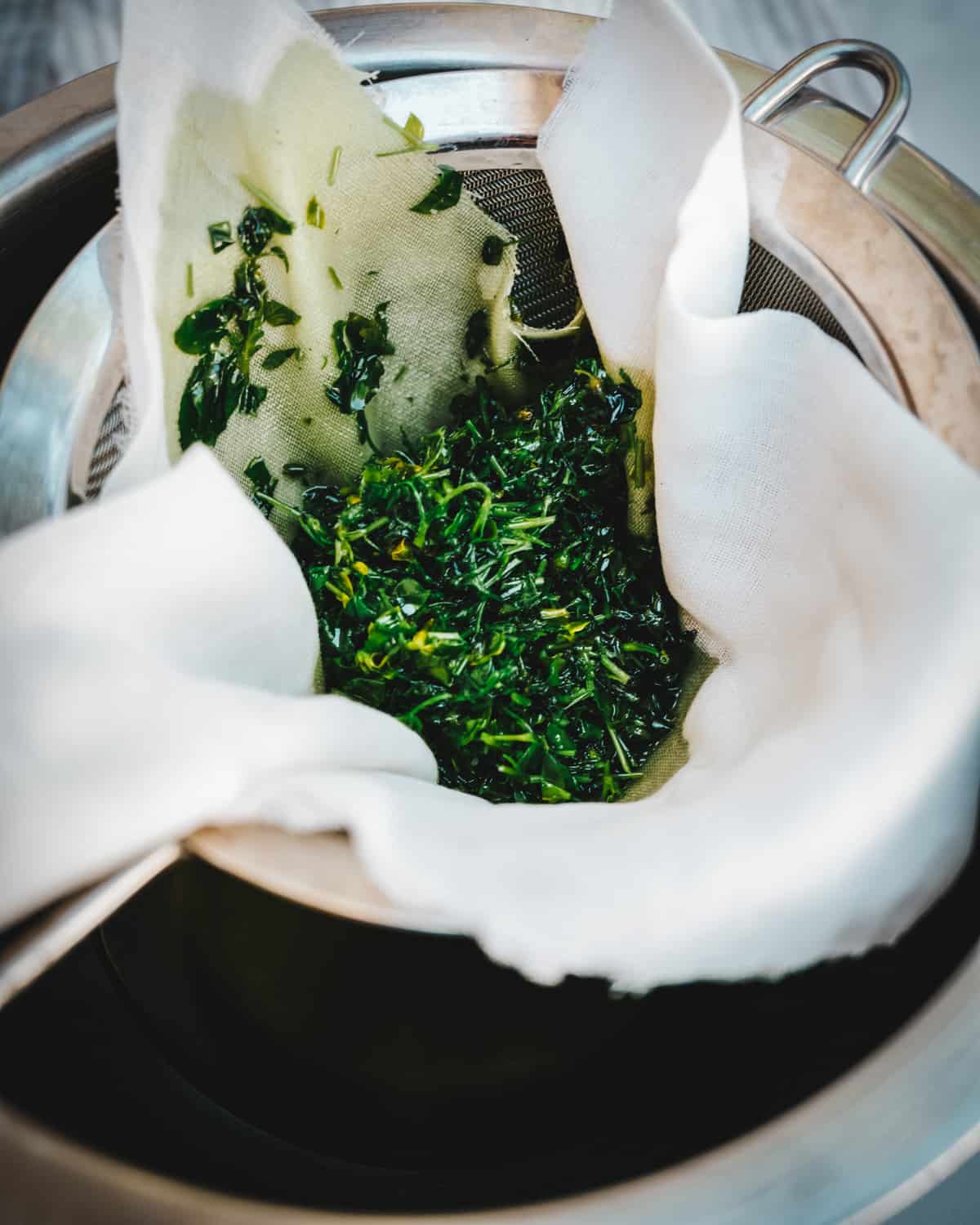
Squeeze the chickweed in the muslin cloth to get all of the medicinal goodness out of the infused oil.
Store the oil in a cool dark place. The oil will last about a year, and can be used straight as is, or can be added to make creams and salves.
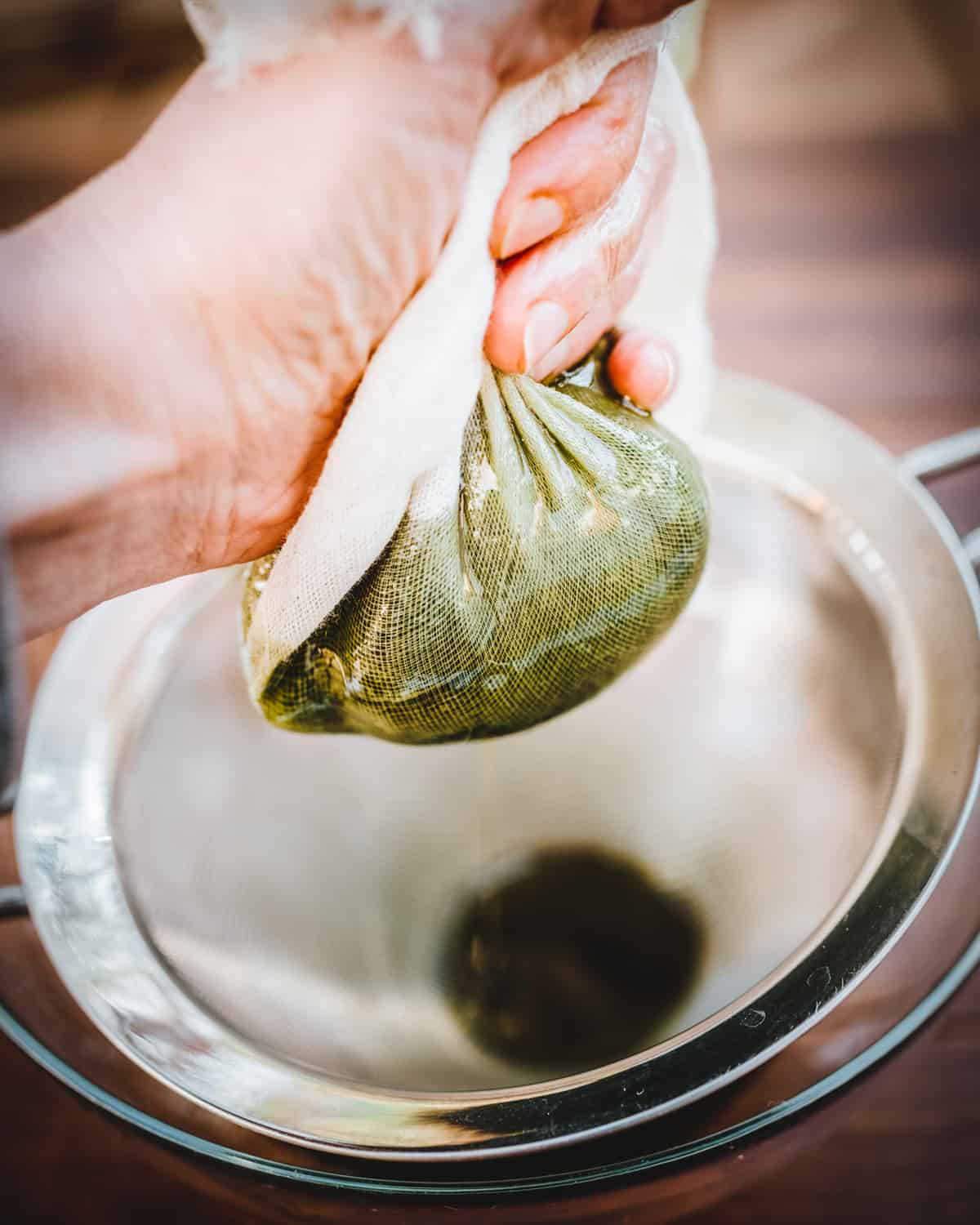
How to Make Chickweed Salve
This is an easy salve to make and it’s highly useful to have this healing and soothing salve in your herbal apothecary. It will be reached for again and again on life’s journey!
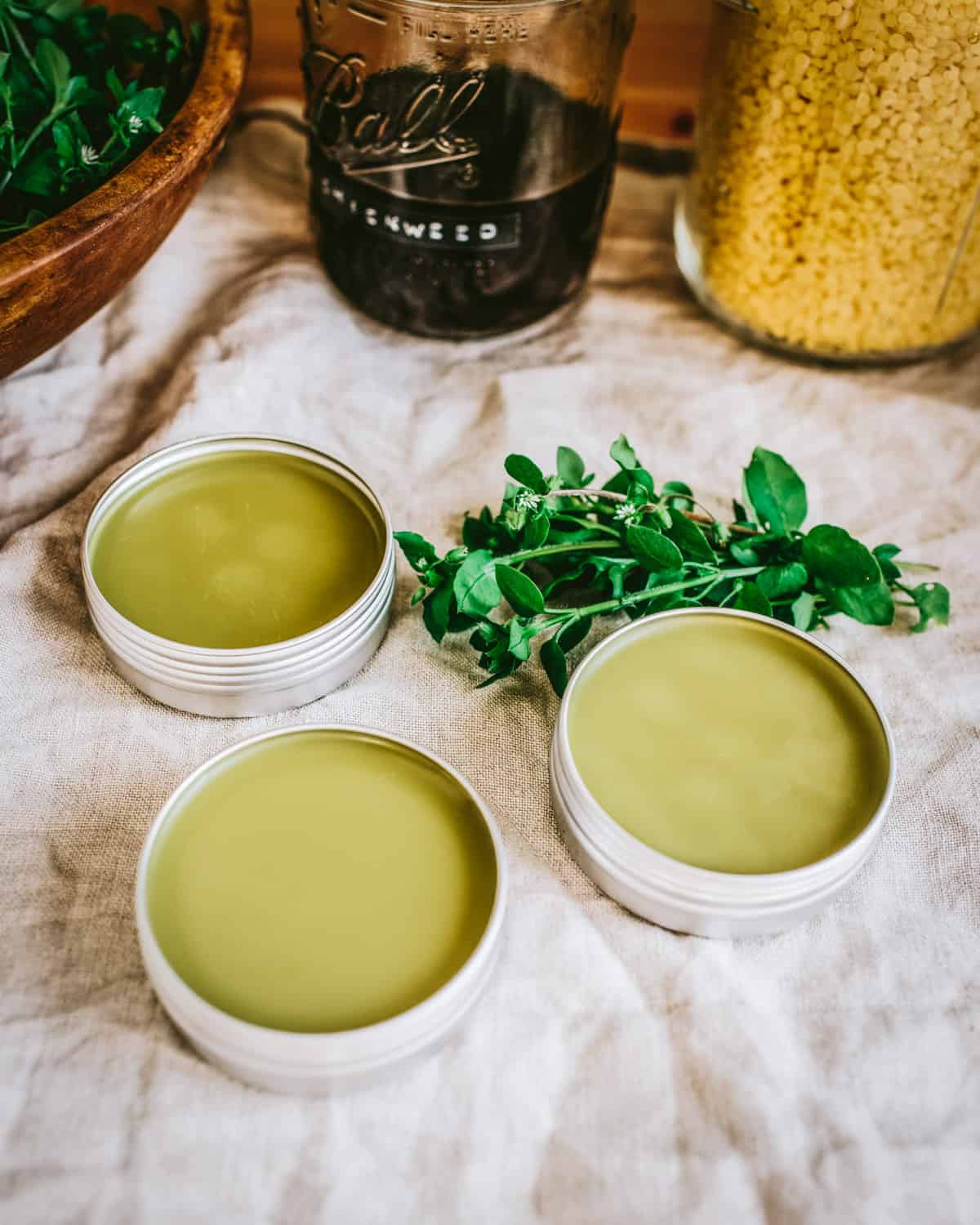
Melt The Oil and Beeswax
First, prep the containers you will use to store the salve, so they are ready to go when the oils are melted, hot, and ready for pouring.
Next, using a kitchen scale, measure the coconut oil and beeswax. Beeswax pellets or shaved beeswax from a block are both ok to use.
Place a double boiler in a pot, filling the pot with water first.
Place 2 oz coconut oil and 1 oz beeswax in the double boiler, and heat on low until the beeswax melts completely. Use a chopstick or bamboo skewer to gently stir the beeswax as it melts.
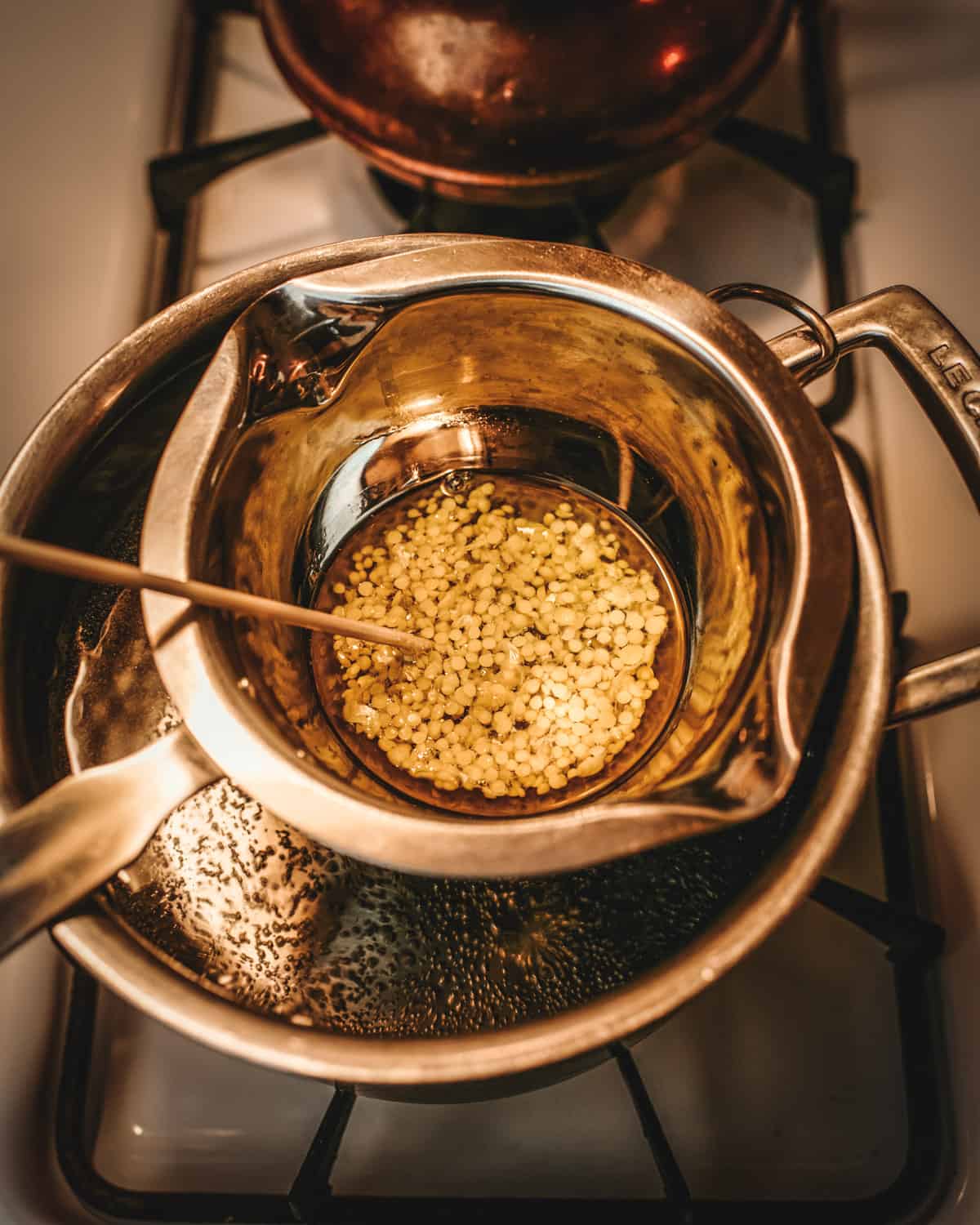
Once the beeswax is melted, add 1 cup of the chickweed-infused oil and mix it to incorporate. Since the chickweed-infused oil is cold, adding it will cause the beeswax to harden.
Simply heat for another minute or so on low, stirring until the mixture is liquid again
Turn off the heat and add a few drops of the optional essential oils if desired. I added about 5 drops each of lavender and helichrysum essential oils and it turned out to be a great combination!
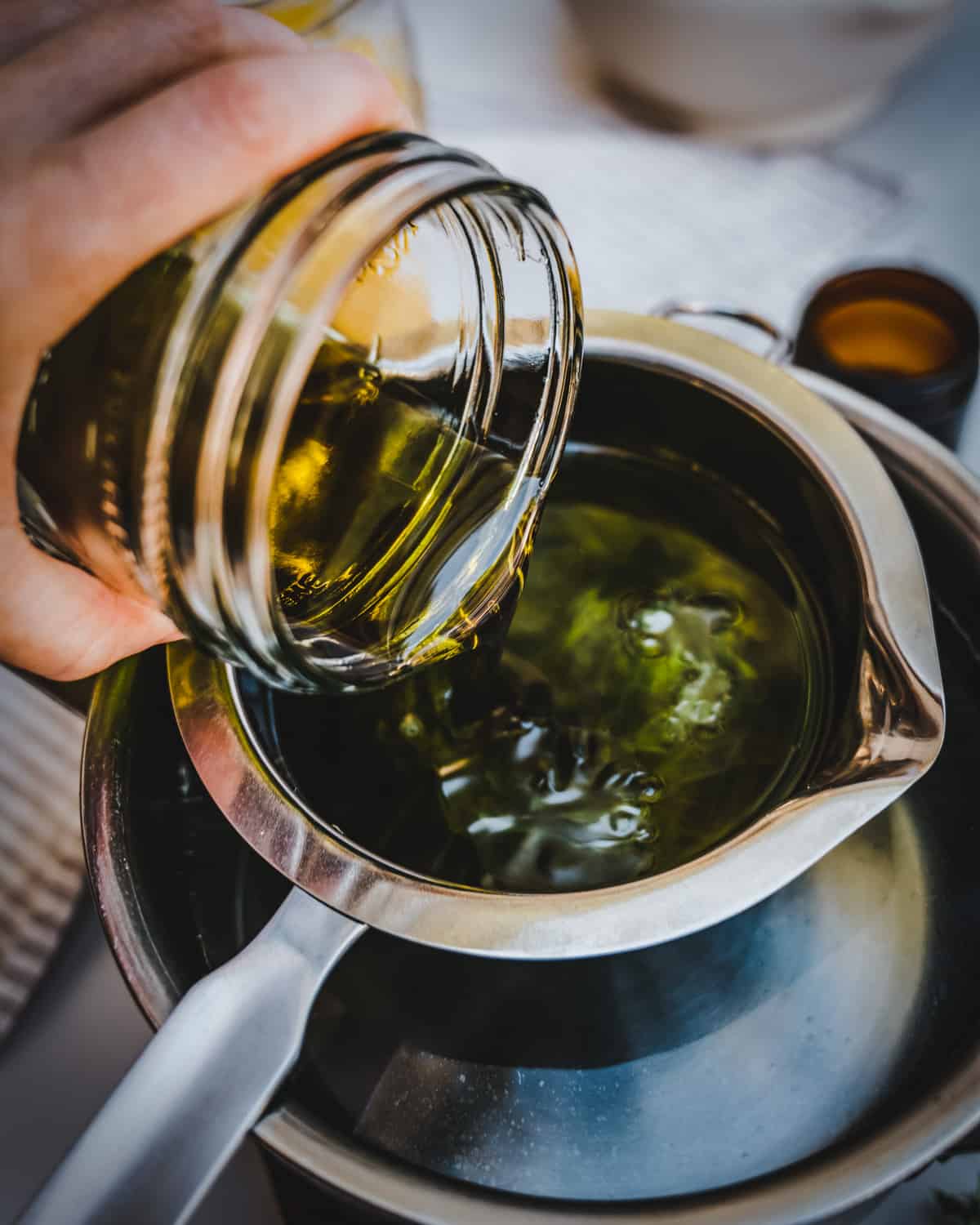
Pour Into Containers
Without delay, pour the hot salve into clean glass jars or tins. The salve will begin to harden almost immediately.
Cover the containers, and store them in a cool dark place.
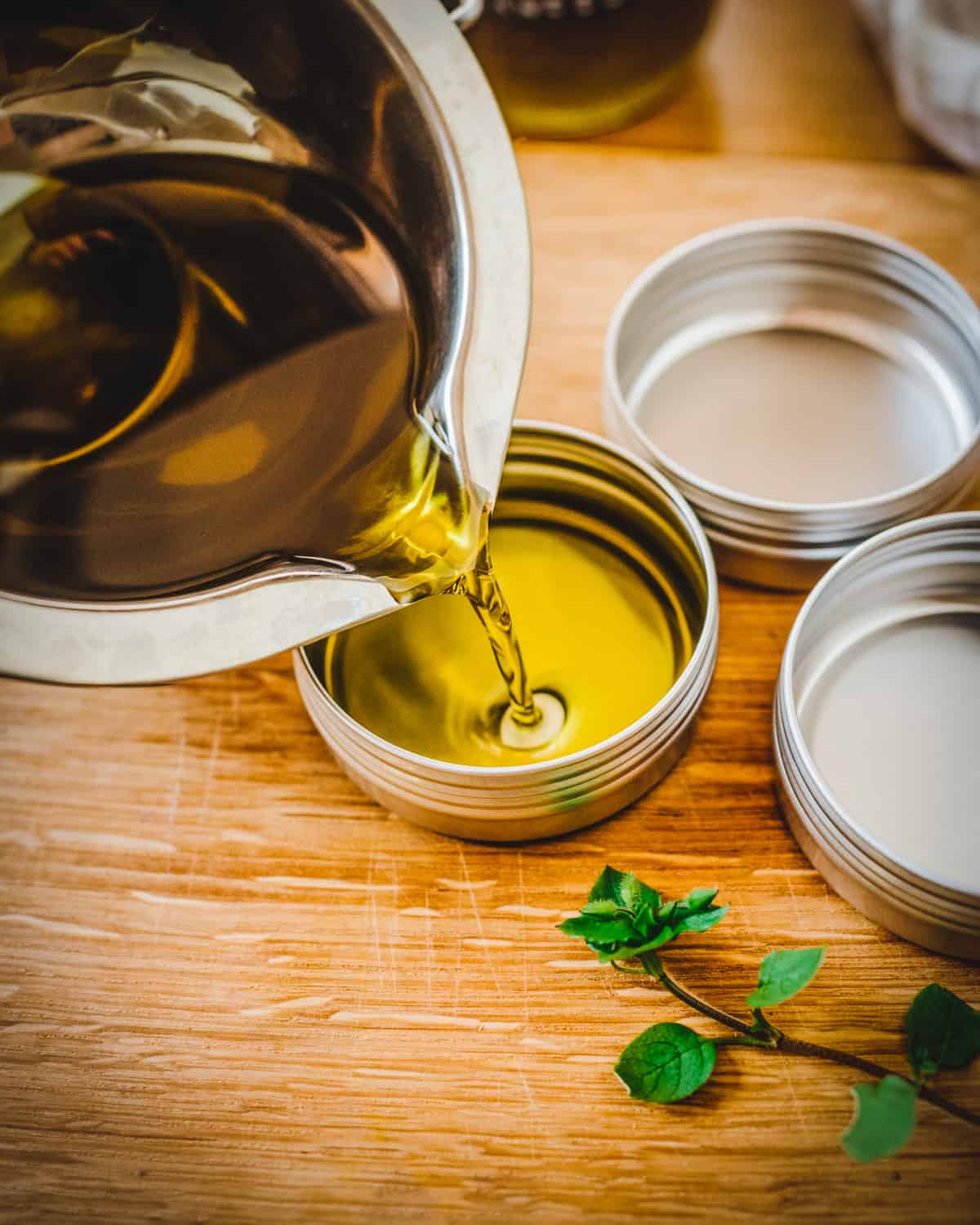
How to Use Chickweed Salve
This lovely salve can be applied topically to soothe bug bites, rashes, to help draw out infections and splinters.
It will also aid in healing minor scrapes, wounds, burns, acne, and healing dry cracked skin.
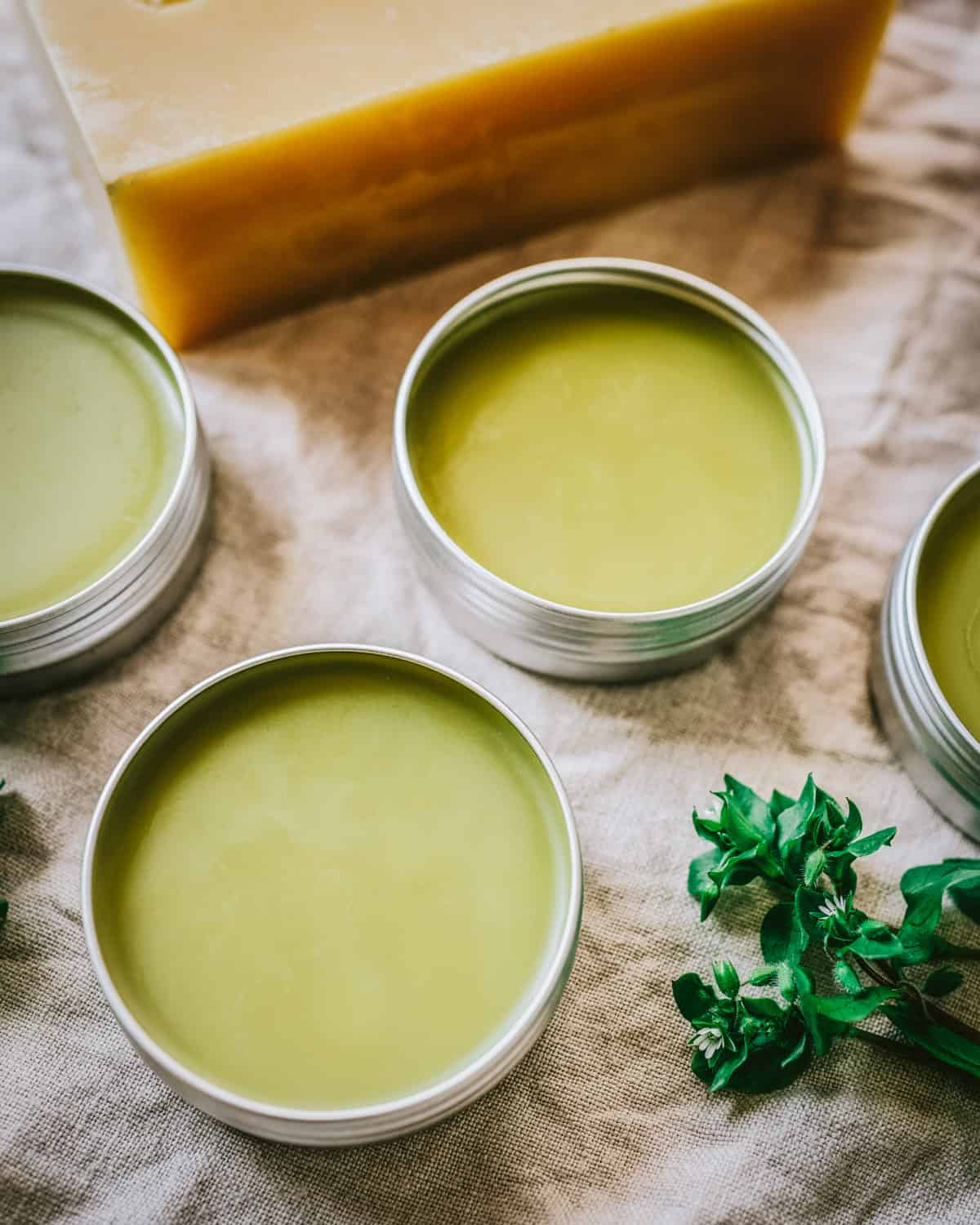
Chickweed salve can last up to a year or more if it is not all used up by then.

It’s likely to be a go-to heal-all for the whole family, so chances are you will be making more the next time chickweed pops its late-winter or early-spring greens out!

More Salve Recipes
- Calendula Salve
- How to Make a Yarrow Plant Salve
- Plantain Salve
- Manuka Honey Salve
- Dandelion Salve
- St. John’s Wort Salve
- Comfrey Salve
- How to Make an Herbal Salve
- 10 Herbal Salve Recipes for Natural Skin Care
- Pine Salve
Chickweed Salve
Equipment
- Dehydrator or Yogurt Maker (optional)
- Small Glass Measuring Cup or metal bowl to make a double boiler
Ingredients
Chickweed Infused Oil
- 2 handfuls foraged chickweed
- 1 cup olive oil
Chickweed Salve
- 1 cup chickweed infused oil
- 2 oz coconut oil
- 1 oz beeswax
- 5-10 drops lavender essential oil optional
- 5-10 drops helichrysum essential oil optional
Instructions
Chickweed Infused Oil
- Rinse the chickweed if needed and gently pat dry.
- Spread the chickweed on a flat surface out of direct sunlight, such as a large cutting board, and leave for about 12 hours or overnight to wilt.
- Once the chickweed is partially dried, chop it finely with a knife and place it in a pint jar. Cover with extra virgin olive oil.
- Heat the oil at a very low temperature for the next 24 to 48 hours to infuse the plant into the oil and allow any water to evaporate off.
- You can use several methods to infuse the oil using heat (see the blog post or the notes section for more details). The key is to heat the oil at a very low temperature (ideally no higher than 100 degrees Fahrenheit).
- The oil will turn dark green and smell somewhat like chickweed once it is well infused.
- Strain the oil with a fine mesh strainer layered with cheesecloth. Store the oil in a glass jar in a cool dark place. The oil will last about a year, and can be used straight as is, or added to creams and salves.
Chickweed Salve
- Prepare the tins so they are ready for pouring the salve in when it is melted and hot.
- Create a makeshift double boiler by putting a small bowl or a glass Pyrex measuring cup over a pot with about an inch of simmering water.
- Place 2 oz coconut oil and 1 oz beeswax in the double boiler, and heat on low until the beeswax melts completely. Use a chopstick or bamboo skewer to gently stir the beeswax as it melts.
- Once the beeswax is melted, add 1 cup of chickweed infused oil. Mix to incorporate. The cold chickweed oil will cause the beeswax to harden.
- Heat for another minute or two on low, stirring until the mixture is liquid again.
- Turn off the heat and add the essential oils (if desired).
- Immediately pour the hot salve into clean glass jars or tins. The salve will begin to harden quickly.
- Cover the containers, and store in a cool dark place.
Notes
- Stovetop method – Place the oil and herb in a double boiler and heat on very low, using a thermometer to make sure you only heat it to 100 degrees Fahrenheit. Turn on and off for the next 24 to 48 hours, allowing any water in the plant to evaporate off and the medicine to infuse into the oil. Do not let the oil come to a boil.
- Yogurt maker – Place the chickweed and oil in a pint jar. Close the lid, and place it inside the glass canister of the yogurt maker. Place the cover on the yogurt maker and fill the reservoir with water. Set the temperature to 100 degrees Fahrenheit and the time for 24 hours. Check the oil after 24 hours and infuse longer if needed. I let mine infuse for about 36 hours in my yogurt maker.
- Dehydrator – Set the temperature to 100 degrees and place the jar with the chickweed and oil in the dehydrator for 24-48 hours.

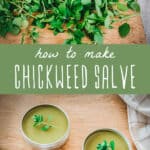
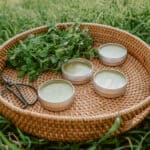

Hello, i followed this recipe for chickweed and also cleavers. My oil does not smell rancid, but it does have an odd odor. Is this normal? I thought it might simply be the scent of these two herbs but do not want to waste more herb or ingredients to make a salve. Thank you. Love your site and sharing your knowledge.
Hi Melanie. I’m honestly not sure of the smell you’re referring to, so it’s hard for me to say if it’s normal or not. Herb infused oils typically smell grassy and green. If it’s not like that, and actually smells bad, I would toss it.
what would be the best-sized tin to use with this salve?
I usually use 2 oz. tins, but you do whichever you prefer. There’s a link to the tin sizes on the recipe card.
Would the completed infused chickweed oil, blend well with other infused oils for a grander healing salve? Like maybe Plantain or Dead Nettle, or Dandelion?
Yup!
I can’t find any way to heat oil at 100c for 24 hours. A double boiler would evaporate water, crockpot is too warm. The yoghurt setting in my convection oven is 40c. The longest setting is 120 minutes.
Regards
Julie
You can add the chickweed to a jar and let them infuse in oil for a up to six weeks instead.
I used the stove top method, and left the herbs in the oil for about the last month and the oil has a super strong smell, almost like… pepperoni?? Do you think it’s gone bad or do strong infusions just kinda smell weird?
Hm, I’ve never heard of salve smelling like pepperoni! As long as the plant material was fully submerged under the oil, there’s no mold, and the smell isn’t completely off-putting, it should be safe to use.
Can you use cold infusion for this oil? Just let it sit in a jar in oil for 6 weeks?
Yup, that works!
can we apply chickweed olive oil infusion in facial and what are the benefits